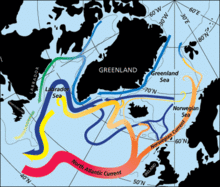North Atlantic Current

The North Atlantic Current (NAC), also known as North Atlantic Drift and North Atlantic Sea Movement, is a powerful warm western boundary current that extends the Gulf Stream north-eastward.[1]
The NAC originates from where the Gulf Stream turns north at the Southeast Newfoundland Rise, a submarine ridge that stretches south-east from the Grand Banks. The NAC flows northward east of the Grand Banks, from 40°N to 51°N, before turning sharply east to cross the Atlantic. It transports more warm tropical water to northern latitudes than any other boundary current; more than 40 Sv in the south and 20 Sv as it crosses the Mid-Atlantic Ridge. It reaches speeds of 2 knots near the North American coast. Directed by topography, the NAC meanders heavily but, in contrast to the meanders of the Gulf Stream, the NAC meanders remain stable without breaking off into eddies.[1]
The colder parts of the Gulf Stream turn northward near the "tail" of the Grand Banks at 50°W where the Azores Current branches off to flow south of the Azores. From there the NAC flow north-eastward east of the Flemish Cap (47°N, 45°W). Approaching the Mid-Atlantic Ridge, it then turns eastward and becomes much broader and more diffuse. It then splits into a colder, north-eastern branch and a warmer eastern branch. As the warmer branch turns southward most of the subtropical component of the Gulf Stream has been diverted southward and, as a consequence, the North Atlantic is mostly supplied by subpolar waters, including a contribution from the Labrador Current recirculated into the NAC at 45°N.[2]
West of Continental Europe, it splits into two major branches. One branch goes southeast, later to become the Canary Current as it passes northwest Africa and turns southwest. The other major branch continues north along the coast of Northwestern Europe. Other branches include the Irminger Current and the Norwegian Current. Driven by the global thermohaline circulation (THC), the North Atlantic Current is part of the wind-driven Gulf Stream, which goes further east and north from the North American coast across the Atlantic and into the Arctic Ocean.
The North Atlantic Current, together with the Gulf Stream, have a long-lived reputation for having a considerable warming influence on European climate. The principal cause for differences in winter climate between North America and Europe is, however, winds rather than ocean currents.[3]
See also
References
- Notes
- 1 2 Rossby 1996, Abstract
- ↑ Lozier, Owens & Curry 1995, Circulation: Figs 10 and 11, pp. 20–22
- ↑ Seager et al. 2002, Abstract
- Sources
- Lozier, M. S.; Owens, W. B.; Curry, R. G. (1995). "The climatology of the North Atlantic" (PDF). Progress in Oceanography. 36 (1): 1–44. Retrieved 19 November 2016.
- Rossby, T. (1996). "The North Atlantic Current and surrounding waters: At the crossroads" (PDF). Reviews of Geophysics. 34 (4): 463–481. doi:10.1029/96RG02214. Retrieved 19 November 2016.
- Seager, R.; Battisti, D. S.; Yin, J.; Gordon, N.; Naik, N.; Clement, A. C.; Cane, M. A. (2002). "Is the Gulf Stream responsible for Europe's mild winters?" (PDF). Quarterly Journal of the Royal Meteorological Society. 128 (586): 2563–2586. doi:10.1256/qj.01.128. Retrieved 25 October 2010.
External links
- The North Atlantic Current. Elizabeth Rowe, Arthur J. Mariano, Edward H. Ryan, The Cooperative Institute for Marine and Atmospheric Studies